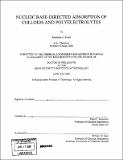Nucleic base-directed adsorption of colloids and polyelectrolytes
Author(s)
Terrot, Marianne S. (Marianne Simon)
DownloadFull printable version (22.38Mb)
Other Contributors
Massachusetts Institute of Technology. Dept. of Chemical Engineering.
Advisor
Paula T. Hammond.
Terms of use
Metadata
Show full item recordAbstract
The primary objective of this work has been the advancement of selective adsorption techniques by use of new interactions and development of new approaches to the directed assembly of colloidal species. The ability to control the assembly from solution of complex and composite surface arrays by chemical patterning of surfaces is of great interest for the creation of nano- and micro-scale features without the costs and constraints of traditional lithography. Previous work in this group having demonstrated the patterning of polyelectrolyte multilayers by assembly on chemically-patterned surfaces, this thesis features a variation of selective adsorption in which polyelectrolytes of known substrate selectivity control the adsorption of the colloids onto which they are layered. The first section of this thesis will describe the evolution of this technique in response to certain limitations inherent to the patterning of multilayered films. Perfluorinated surfaces, proposed as potential adsorption resists, were found to display only partial or relative selectivity to common polyelectrolytes in the context of layer-by-layer assembly, an observation consistent with trends predicted by free-energy modeling. However, when these same polymers were layered on colloids, absolute selectivity could be more easily achieved. (cont.) Polyamine-directed colloidal assembly was studied first, demonstrating that layer-by-layer selectivity observations still held in this new approach and illustrating some unique advantages with regards to multicomponent assembly. To expand the reach of selective adsorption, specific recognition via multiple hydrogen bonding was explored as a guiding interaction. Nucleic base pairing, the MHB system at the heart of molecular biology, proved highly effective for selectivity. In particular, the mutual indifference of non-complementary groups makes MHB ideally suited to side-by-side deposition of different species. Natural RNA homopolymers were used at first for surface and colloidal modification, but proved too fragile and costly for extensive use. Instead, novel biomimetic polymers combining nucleic base side chains and stable backbone charge were synthesized, along with nucleic base-terminated triethoxysilanes for facile microcontact printing of nucleic base patterns. These new materials successfully replaced RNA as directors of selective assembly while improving reproducibility; in particular, their stability allowed exploration of new approaches to asymmetric functionalization. (cont.) Multilayered films of these polymers were also studied and found to exhibit interesting responses to changes in chemical environment. In the last section of this thesis, the synthesis and characterization of the nucleic base-grafted polyelectrolytes and triethoxysilanes will be reported.
Description
Thesis (Ph. D.)--Massachusetts Institute of Technology, Dept. of Chemical Engineering, February 2007. "January 2007." Includes bibliographical references.
Date issued
2007Department
Massachusetts Institute of Technology. Department of Chemical EngineeringPublisher
Massachusetts Institute of Technology
Keywords
Chemical Engineering.